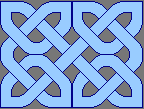Celtic Knotwork
Here are several ways to draw your own celtic knotwork.
There are many methods for drawing celtic knotwork. Each method has its advantages and disadvantages. The method you choose will depend on the details of your project and, of course, your preferences.
These pages provide (admittedly uneven) coverage of a few of the most popular methods. Far richer instructions for each method are available in books by the respective authors. My intention is to provide a basic introduction to each method, especially for readers who have never drawn knotwork before. These pages are not intended to supplant the original works. I strongly advise you to visit the Celtic Bibliography Page for complete information about the books from which these methods are drawn.
Genuine knotwork has a number of general properties that you should be familiar with. You might also want to take a look at the eight basic knotwork patterns identified by J. Romilly Allen.
A lot of people email me asking about the origin and meaning of celtic knotwork, which is why I put all that information on its own page.
Iain Bain has very concise methods of drawing 4-cord knotwork and 3-cord knotwork. His methods are great if you have rectangular spaces that are easily divided into squares. It's not so good if you have irregular or curved spaces to fill with knotwork. These methods are highly recommended for beginners.
Andy Sloss has a unique method of building a knotwork pattern square by square. He starts by enumerating all the ways in which cords can pass through a given square. Building the overall pattern, then, is simply a matter of repeating the various possibilities in the right sequence to achieve your desired pattern. This method lends itself to quite naturally to computer-based knotwork, because the process of creating and duplicating the squares is very easy with a computer.
Aidan Meehan has a whole series of books about celtic artwork, one of which is on the subject of knotwork. Although Meehan's method is one that I do not use regularly, the book brings up a number of interesting ideas. Further information will be coming in the future.
Sheila Sturrock has a book that is light on methodology, but contains many examples of interesting knots, including heart motifs and zoomorphics (animal shapes).
Marc Wallace has a Web page describing his method of creating simplified knots. One advantage of his technique is that you don't have to spend a lot of time drawing gridlines.
Christian Mercat has developed an interesting method of creating knotwork in an arbitrary space. His method is on the Web in french and english.

A variation on simple knotwork is double interlacing. Right now, I have just one example online, but I hope to put together a whole page of instructions on the subject.
One popular knotwork theme is the celtic cross. I have a page showing a celtic cross that I've drawn.


